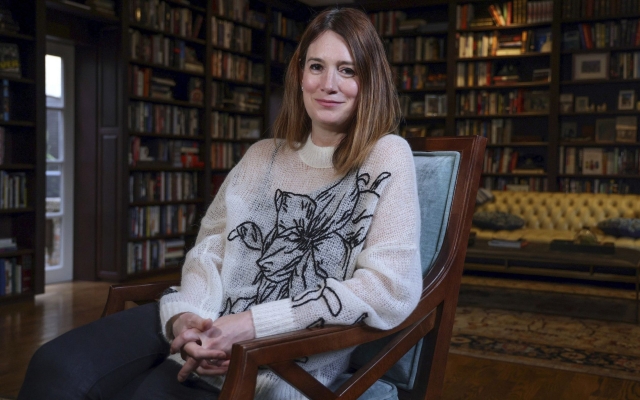 Ben Affleck in the film Gone Girl
Ben Affleck in the film Gone Girl
The 2012 novel Gone Girl became one of the publishing sensations of the 21st century. Gillian Flynn's crime thriller sold 20 million copies worldwide, topped the New York Times bestseller list and was made into a 2014 film starring Rosamund Pike and Ben Affleck.
The twisty plot — as if you didn't know it — centers on a husband who becomes the prime suspect in his wife's murder after she mysteriously disappears, only to discover that the wife orchestrated the whole thing and faked her grisly disappearance in order to teach her lecherous husband is a lesson. The book spawned a whole genre of similar novels with an unreliable female narrator and invariably containing the word “girl” in the title (“The Girl on the Train,” “The Good Girl,” “The Happiest Girl in the World,” “Dangerous Girls”). It even led to the Netflix satire The Woman in the House Opposite the Girl in the Window.
Now the Gone Girl phenomenon is back with a vengeance thanks to a true crime documentary on Netflix called American Nightmare. The three-part series, released this week, has taken the internet by storm and is already the streamer's most-watched show in the UK. The focus is on the 2015 case of California couple Aaron Quinn and Denise Haskins. One night she was kidnapped from their bed by assailants in wetsuits and he reported it to the police, only to be accused of killing her and making the whole thing up. The media immediately dubbed the case «The Missing Girl in Real Life.» And to drive home the point, American Nightmare is replete with clips from the film. Viewers are going crazy for the documentary (“Oh my god, this shit is wild!” says a typical TikTok review).

Twelve years after its release, it seems like Gone Girl has become a true crime phenomenon, although in fact it is not. Forget looking in the mirror—we've stepped through a detective's magnifying glass into the shaky world where a TV documentary is framed as a real-life version of a film based on a work of fiction. «American Nightmare» is far from alone.
Numerous disappearance cases have been compared to «Gone Girl» over the years, and the term «Gone Girl Fraud» has become something of a tabloid slogan. What else is real? Who imitates whom? Hard to say. The only thing that's certain right now is that Netflix has a sure-fire hit with a copper bottom. Call the police.
Flynn was always careful to emphasize that Gone Girl was a work of fiction. In a conversation with Entertainment Weekly in 2012, the author emphasized that her novel is not based on any specific incidents from the past. The word «specific» did a lot of the heavy lifting there. Because Flynn, a self-confessed “true crime junkie,” went on to say that one real-life incident had some influence on her book. In the early 2000s, the story of Scott and Lacey Peterson captivated America.
 Gone Girl author Gillian Flynn Photo: Getty
Gone Girl author Gillian Flynn Photo: Getty
In December 2002, eight months pregnant, Lacy Peterson disappeared from the couple's home in California (always California). She was reported missing by her husband Scott, and her remains were discovered the following April near San Francisco. He was arrested and charged with murdering her and their unborn child (he is currently serving a life sentence, but has always maintained his innocence). Flynn believes the case made headlines in part because the couple were beautiful (“you don’t usually see incredibly ugly people go missing and it becomes a sensation,” she said).
So, Gone Girl couple Nick and Amy Dunne are an attractive couple, as, naturally, are their on-screen alter-egos Affleck and Pike. But there was another conceit that Flynn played with: the assumption that the husband always does nothing. “My wife is missing; you assume that the husband did it. It was a very interesting idea for me,” she told Entertainment Weekly.
Gone Girl played with this premise to great effect. But once the published novel became the standard against which other cases were compared, things got really interesting. In 2016, Sherry Papini disappeared while jogging in Redding, California. About three weeks later, the married mother was found 150 miles away with a chain around her waist, bruises on her legs, a shaved head and a broken nose. There were hose clamps attached to her ankles and a brand on her shoulder.
 Sherry Papini, who admitted to faking her own kidnapping in 2022
Sherry Papini, who admitted to faking her own kidnapping in 2022
She said she was kidnapped by two Latina women armed with guns and tortured. None of this was true. The investigation lasted six years. But in 2022, Papini admitted that it was a hoax. She was with her ex-lover all the time. “Gone Girl Wannabe” was a typical turn of phrase in tabloid reporting. In this case, the storyline of «Gone Girl» was reproduced.
However, a few years later things were a little different. In May 2019, a Connecticut mom (with apologies to California) named Jennifer Dulos went missing. The main suspect was her ex-husband Fotis Dulos. This suspicion grew stronger when Fotis and his girlfriend were allegedly caught on video throwing garbage bags of bloody clothes into a variety of different trash cans (not a good idea if your wife has disappeared). But unexpectedly, Fotis Dulos used “Gone Girl” to defend himself against the charges.
His lawyer, Norm Pattis, suggested to the New York Post that Jennifer staged her own disappearance, similar to Gone Girl. He told the newspaper that she had previously written a manuscript that was somewhat similar to Flynn's book. He also told NBC News that «we don't know what happened to Jennifer, but the Gone Girl hypothesis is very exciting to us.»
 Denise Haskins and Aaron Quinn in the movie “American Nightmare” Photo: Netflix
Denise Haskins and Aaron Quinn in the movie “American Nightmare” Photo: Netflix
Flynn's book became a legal tool. Jennifer's family, as well as Flynn herself, sharply criticized the defense line. “I am absolutely disgusted that a work of fiction I wrote was used by Fotis Dulos' lawyer as a defense and as a hypothetical, sensationalist motive for the very real and very tragic disappearance of Jennifer,” the author said. Fotis Dulos committed suicide in 2020, and Jennifer's body was never found. Dulos' girlfriend, Michelle Troconis, is currently under investigation for aiding an alleged cover-up, conspiracy to commit murder, tampering with evidence and hindering prosecution; she insists she doesn't know what happened to Jennifer and has pleaded not guilty.
This brings us to American Nightmare and the latest version of Gone Girl. If you haven't seen it yet, stop reading here: spoilers follow. Because the most memorable thing about the Quinn/Haskins case is that it doesn't have any of the Gone Girl twists at all. The big revelation is that Aaron Quinn was telling the truth all along: his girlfriend Denise Haskins was kidnapped exactly as he described. She was also raped twice. The «Gone Girl» theory was brought into the case by the police themselves and quickly picked up by the media.

In the documentary, we see the evocatively named Detective Mat Mustard (in the library, holding a candlestick) accusing Quinn of kidnapping his girlfriend and letting her body rot. Mustard later interrogates a clearly traumatized Haskins in a police interview room with shockingly little compassion. Haskins' incredulous lawyer told the program that an FBI agent named David Sesma once asked him, «Haven't you seen the movie Gone Girl?»
The lawyer tells the documentary: “How could this man, who is facing criminal charges, think this is like a Ben Affleck movie? This is Hollywood. This is real life.» The lawyer claims «confirmation bias»: the cops were so confident in their Gone Girl theory that nothing could knock it out of their minds.
A former Marine named Matthew Mueller was found guilty of rape and false imprisonment in March 2016 and is currently serving a 40-year sentence. Quinn and Haskins sued the police department. They were awarded $2.5 million out of court.
 Matthew Mueller, convicted of rape and false imprisonment in 2016 year. Photo: Netflix
Matthew Mueller, convicted of rape and false imprisonment in 2016 year. Photo: Netflix
But the on-screen plot twists — and there are many of them — are just one of the reasons why «American Nightmare» is becoming so popular. As viewers, we become part of the conspiracy. We find ourselves making assumptions about people's guilt — and in the process we are made to look like idiots. As with the police, we have «Gone Missing Girl.» Sitting on the couch, we all think the guy did it. Of course it was him. They fool us more. And then, when we learn the truth, we resent the injustice of it all, the callousness of the great institution we initially assumed we could trust (shades of Mr. Bates vs. the Post Office here). We also cry for the happy ending.
The television associated with Gone Girl shows no signs of disappearance. In 2016, Flynn said the novel that inspired her book was the 1978 mystery novel The Westing Game by Ellen Raskin. This book is about a wealthy businessman named Sam Westing who dies and tasks his 16 heirs with finding out which of them killed him. The heirs, all of whom live in the same apartment building, are grouped into eight pairs, and the couple who solves the mystery will inherit his $200 million and his business. It sounds like a cross between «Only Murders in the Building» and «Knives Out», both of which are very popular. In 2020, it was announced that HBO was working on an adaptation of The Westing Game.
So the connection between true crime and Gone Girl -style «unreliable narrator» stories looks set to be the focus of television for a while. They have become a mixed genre. Real life? Fiction? The audience doesn't mind. As one of Haskins' neighbors told ABC 7 News after her disappearance, «Sometimes life is stranger than fiction.» And we lap it up.



















































Свежие комментарии